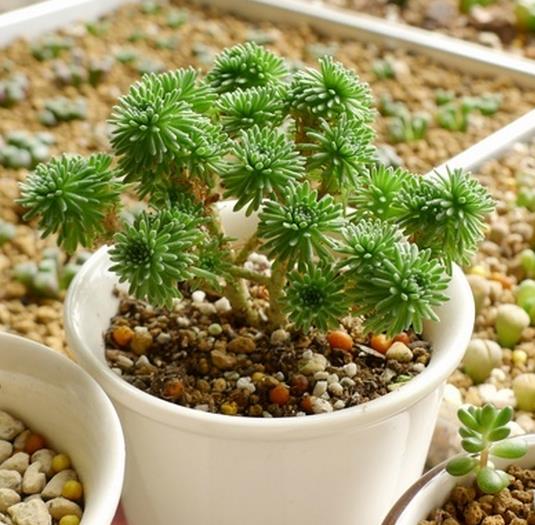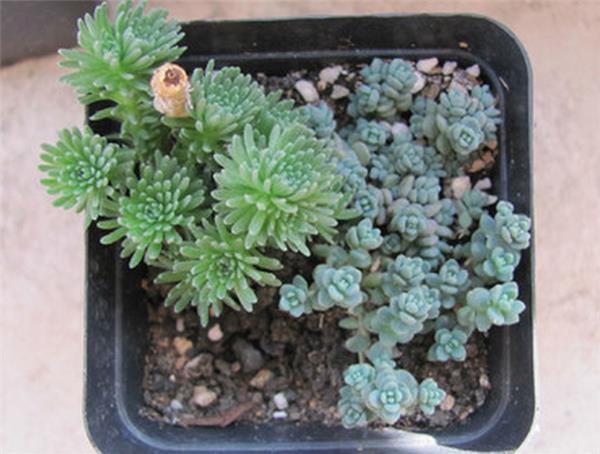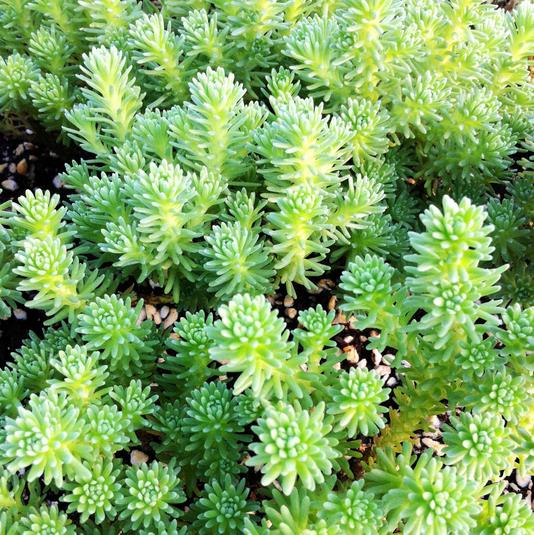Introduction and culture skills of cute Pinus elliottii in green plant
Cone pine has a high ornamental value, is a commonly used plant decoration at home, the shape of the ball pine is round, furry as pine leaves, is worthy of people's love. Next, let's take a look at the relevant knowledge of ball pine.

First, the introduction of ball pine
Ball pine alias small pine green, is the family Sedum succulent plants (succulent plants), succulent needles, evergreen herbs, native to Africa, Algeria, has a high ornamental value. Small pine green plants are short, branched very short, stick to the succulent stem with bunches of maroon hairs, needles about 1 meter long, clusters at the tip of the branch, lush green, yellow flowers. Small pine green like warm and dry, but also can withstand half-shade, afraid of waterlogging. The cone pine plant is low, much branched, the plant type is nearly globular, the old stem is gray-white, the new branch is light green, and then gradually turns gray-brown, the fleshy leaves are similar to needle, but slightly wider, about 1cm, clustered on the branches, green, the old leaves dry and stick to the branches, forming a similar pine bark-like cracking, it takes a long time to fall off, revealing the smooth fleshy stem. Conifer florets yellow, stellate.

2. cultivation techniques of Pinus elliottii
Ball pine can be planted with soil with good permeability, the flowerpot is not easy to be too large, and the summer temperature is semi-dormant when the temperature is above 27 ℃. Watering should be controlled, and the pot soil should be fully dried and watered again, and half-shaded. It overwinters indoors in winter, the lowest temperature is above 5 ℃, and it can continue to grow under the condition of sufficient sunshine. In the spring and autumn growing season, the fully developed twigs are broken off into a cuttage, inserted in the potted soil, controlled the soil temperature, placed in a place with sufficient scattered light, and rooting in about 10 days to become a new plant.

1. Light
Its growing period is from September to May of the following year, and it can be maintained in a place with sufficient light. If there is not enough sunlight, it will make the plant grow too long, lengthen the distance between leaves and leaves, lose the compact and beautiful plant shape, and seriously affect the ornamental plant.
two。 Fertilizer and water
Ball pine watering to grasp the "dry rather than wet" principle, to avoid long-term stagnant water, so as not to cause rotten roots. In order to keep the beautiful shape of bonsai, it is generally not necessary to apply additional fertilizer in maintenance.
Pinus bulbifera is dormant in high temperature in summer, and the plant growth is stagnant. it can be maintained in a well-ventilated semi-shade place, and pay attention to control watering to avoid rain to prevent plant decay. Move into the place with plenty of light in winter, control watering, make the plant dormant, can withstand 5 ℃ or even lower temperature. The basin is changed once every autumn, the basin soil is required to be loose and breathable, has good drainage, and can be mixed with garden soil, sandy soil and other materials.

3. Pruning
Pinus tabulaeformis is easy to sprout lateral branches, so attention should be paid to pruning and cutting off the dense and disordered branches in time, especially the new branches at the base, so as to keep the bonsai dense and proper, natural and beautiful. It should be pointed out that the branches of Pinus elliottii are thin, so we should pay attention to control the height of the plant so that the proportion between branches and stems is naturally coordinated. For the pruned branches, they can be used as cuttings for cuttings and propagation, and they are easy to survive, regardless of length or short, except in the hot summer season.
4. Daily care
The bonsai is first placed in a place where there is no direct sunlight to slow the seedling for about 7 days, in order to promote the recovery and development of the root system, and then it will be maintained in a place with sufficient light. If there is not enough sunlight, it will make the plant grow too long, the distance between leaves and leaves will be lengthened, and the compact and beautiful plant type will be lost, which will seriously affect the ornamental plants, while the branches and leaves of the plants growing in the sunny places will be short and compact, with the firm and straight charm of pine trees. Watering should master the principle of "don't get wet" to avoid long-term stagnant water so as not to cause rotten roots. In order to keep the beautiful shape of bonsai, it is generally not necessary to apply additional fertilizer in maintenance. Pinus bulbifera is dormant in high temperature in summer, and the plant growth is stagnant, so it can be maintained in a semi-shady place, pay attention to control watering, avoid rain, especially long-term rain, to prevent plant rot. After the plant begins to grow in cool autumn, it will return to normal management. Move into the place with plenty of light in winter, control watering, make the plant dormant, can withstand 5 ℃ or even lower temperature. No less than 10 ℃, it can grow normally. The basin is changed once a year in autumn, the basin soil is required to be loose and breathable, and has good drainage. It can be mixed with garden soil, sand and other materials. When changing the basin, the over-long old roots will be cut short to promote the development of strong new roots.
Pinus elliottii has strong germinating power and is easy to germinate lateral branches. attention should be paid to pruning, cutting off too dense and disorderly branches in time, especially the new branches at the base, so as to keep the bonsai dense and proper, natural and beautiful, and cultivate an independent trunk. For the pruned branches, they can be used as cuttings, dry for 1-2 days, and propagated after the wound is dry. Except for the hot season in midsummer, regardless of length, it is easy to survive. In addition, Pinus elliottii is a succulent plant with foliage and posture (that is, posture, plant type), and its flowers are not beautiful, so it should be cut off in time after inflorescence appears, so as not to consume too much nutrients and be disadvantageous to plant growth.
The above is the knowledge of Qiusong. I hope it will be helpful to you.
In order to promote the development of strong new roots.
Pinus elliottii has strong germinating power and is easy to germinate lateral branches. attention should be paid to pruning, cutting off too dense and disorderly branches in time, especially the new branches at the base, so as to keep the bonsai dense and proper, natural and beautiful, and cultivate an independent trunk. For the pruned branches, they can be used as cuttings, dry for 1-2 days, and propagated after the wound is dry. Except for the hot season in midsummer, regardless of length, it is easy to survive. In addition, Pinus elliottii is a succulent plant with foliage and posture (that is, posture, plant type), and its flowers are not beautiful, so it should be cut off in time after inflorescence appears, so as not to consume too much nutrients and be disadvantageous to plant growth.
The above is the knowledge of Qiusong. I hope it will be helpful to you.
Related
- Wuhan Hospital Iron Tree Blooming Result Was Instantly Frightened by the Gardener Master
- Which variety of camellia is the most fragrant and best? Which one do you like best?
- What is the small blue coat, the breeding methods and matters needing attention of the succulent plant
- Dormancy time and maintenance management of succulent plants during dormancy
- Minas succulent how to raise, Minas succulent plant pictures
- What are the varieties of winter succulent plants
- How to raise succulent plants in twelve rolls? let's take a look at some experience of breeding twelve rolls.
- Attention should be paid to water control for succulent plants during dormant period (winter and summer)
- Watering experience of twelve rolls of succulent plants
- Techniques for fertilizing succulent plants. An article will let you know how to fertilize succulent plants.



